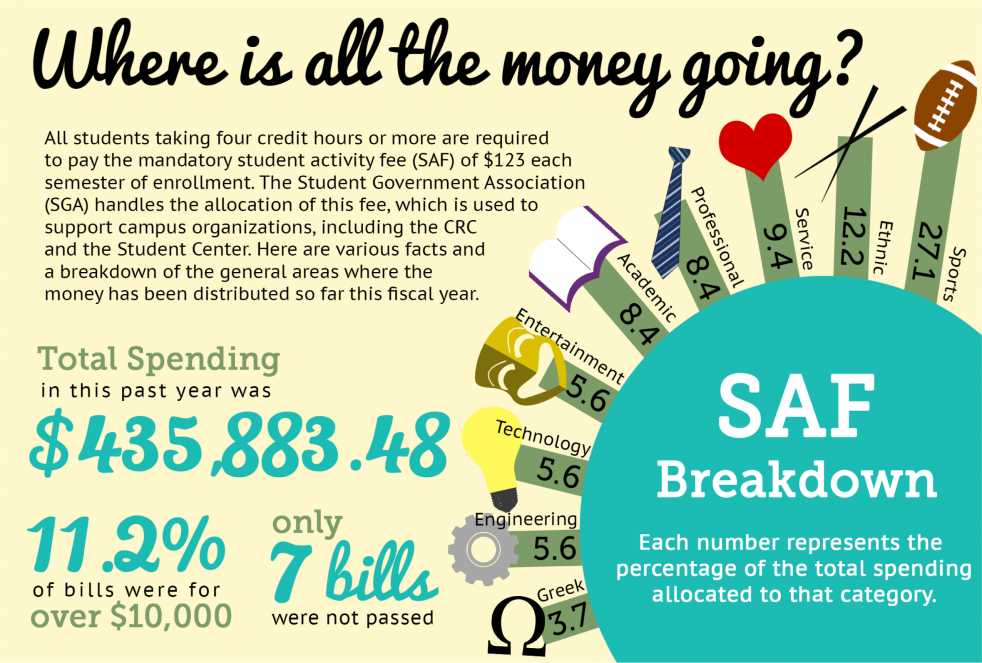Each year, every Tech student pays $123 per semester for the Student Activity Fee (SAF), but most may not realize exactly where their money goes. The SAF goes directly to SGA’s budget for them to distribute to campus organizations.
The SAF is allotted into four categories – the CRC, the Student Center, Student Organizations and Student Publications. This year, 45 percent of the fee went to the CRC, 29 percent to the Student Center, 20 percent to Student Organizations and five percent to Student Publications.
This year, SGA’s budget was $1,211,090. So far, $435,883.48 has been allocated to campus organizations.
“Ultimately, the goal for [SGA] is to ensure that we make effective use of the Student Activity Fee that you and I and every other student on this campus pays every semester,” said Sai Krishna Surapaneni, SGA Undergraduate Treasurer.
The SAF is one of Tech’s mandatory student fees, meaning all students currently enrolled at Tech’s Atlanta campus must pay it. In the fall, 19,761 students paid the SAF, which brought in a total revenue of $4,820,488.
This year, SGA’s budget was $1,211,090. So far, $435,883.48 has been allocated to campus organizations.
SGA’s budget is made up of the Prior Year account and the Capital Outlay account. The Prior Year account used to fund student organization’s “general initiatives.” The Capital Outlay, though, funds “capital expenditures”. This year, the $269,055 went to the Prior Year account and $942,035 to the Capital Outlay account. According to reports made by Surapaneni in the UHR meetings, SGA has spent money at a faster rate historically, and continues to run the risk of running out of their PY account for this fiscal year.
“We can move funds from one to the other…we are probably going to have to this time around. It’s kind of like taking money out of your retirement fund to pay for a sports car. It’s ultimately what we’re going to have to do,” said Representative Gregory Jones, in response to the possibility of running out of the PY account.
“Every club, organization, and society is competing with each other in order to acquire those funds.”
So far this year, 107 bills have been submitted to SGA. The average funding approved per bill was $4136.75 and 12 of the bills passed were for over $10,000.
“There is a lot of competition in order to get funds from the SGA. Every club, organization, and society is competing with each other in order to acquire those funds. Those funds are limited, and the SGA must decide who they should give those funds to,” said Luis Ernesto Hasbun Zamora, the Executive Treasurer for Society of Hispanic Professional Engineers.
The greatest portion of bills, passed through SGA this year went to student athletic clubs. In 2012, student athletic clubs were moved from being categorized under the CRC to Student Organizations for accounting reasons.
After that, the organizations with the largest number of bills were organizations with a focus on technology, such as Robojackets and HyTech Racing, and arts and entertainment organizations, such as DramaTech. Conversely, service and Greek organizations had the smallest number of bills submitted.
“A lot of times, there are some line items or bills that get voted down even though they are for a ‘good cause’. But what it comes down to is, ‘Will the money funded by SGA be put to use in order to benefit the overall student body?’ We as student reps strongly feel that the SAF can be used for one thing and one thing only – to better the overall experience of the student body as a whole,” Surapaneni said.
The SAF, unlike the Health Fee or Athletic Association Fee, will not change for students for the next fiscal year, as SGA recommended no increase in SAF for the third year in a row.
Unlike Georgia Tech, other colleges have increased their Student Activity Fees in recent years.
Georgia State University’s Student Activity Fee is $660. Instead of directly funding SGA and student organizations, unlike Tech’s Student Activity Fee, a majority of GSU’s fee goes to individual university colleges, such as their College of Public Health and College of Arts and Science.
At MIT, the Student Activity Fee is $140 per term. Also, MIT’s Student Activity Fee increased this year by $6. The largest portion of MIT’s Student Activity Fee funds large campus events and club sports. On the other hand, UGA’s Student Activity Fee is $78, $45 less than Tech’s, but UGA’s overall mandatory student fees are $2 more than Tech.
